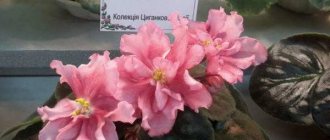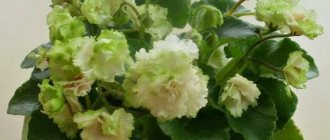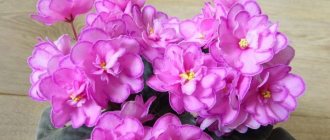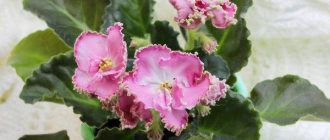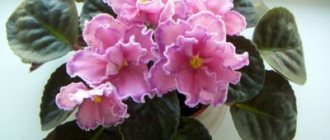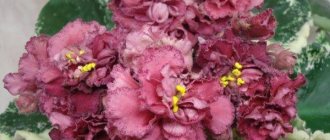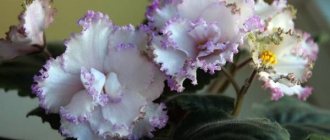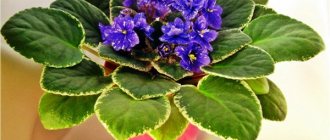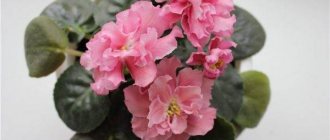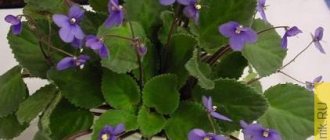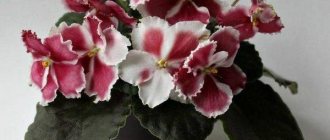In this article you will find a photo and description of the seedling of breeder Konstantin Morev Country of Crimson Clouds SM and read its detailed characteristics.
You will also learn how to properly care for this violet , what conditions are necessary for good growth and flowering. This information will help you avoid common mistakes that lead to disease and death of the plant.
Violet SM Country of Crimson Clouds (Seedling Morev)
The author of this unusual bright Saintpaulia with an intricate name is a breeder from Moscow Konstantin Morev . The name of the seedling appeared thanks to the work of the Strugatsky brothers “Land of Crimson Clouds”.
Meet the Uzambara violet Country of crimson clouds SM:
- family - Gesneriaceae;
- genus – Saintpaulia hybrid;
- flowers are very large, semi-double, gorgeous stars, warm raspberry-terracotta color. The tone towards the center becomes more saturated. The core is yellow. The edges of the petals are decorated with dark red dots. In a cool room, a greenish-bronze edging is formed. It produces many buds. Peduncles are strong, but fall down;
- leaves are dark green with a pink edging along the edge and pink-cream variegation. The socket is neat, smooth, standard. In starters, the variegation may be white, but it changes with age.
SM Country of Crimson Clouds.
The bride's bouquet
The “bridal bouquet” violet is easily recognized by its double, snow-white inflorescences with a wavy edge. The variety's rosette is compact and forms an almost perfect circle. The leaves are dense, dark green.
With long daylight hours, regular watering and comfortable temperatures, the “bridal bouquet” can bloom all year round. The plant grows quickly, so an adult violet will have to be replanted every 6-7 months.
Home care
Seedling care is standard . By creating comfortable conditions for growth and development, the Land of Crimson Clouds will delight SM with abundant flowering.
Watering
An important factor for good plant development is proper watering. The water temperature should be room temperature.
There are several ways to determine the need for watering :
- Before the next watering, check the soil surface. It should dry to a depth of about 1 cm;
- more experienced gardeners weigh the pot on their hand and, based on its approximate weight, decide whether the plant needs watering.
Soil moisture is determined by its color - a dark shade indicates that there is enough moisture.
Important! At elevated air temperatures, violets are watered more often. And in low light conditions - less often.
Water the soil directly, pour water into a tray, and use the wick method. Do not allow water to get on the leaves and center of the rosette. Excess liquid from the pan is drained.
Feeding
Feed no more than once every 10 days with mineral fertilizers intended for flowering plants. Fertilizer is added to the water. The concentration of preparations for violets is halved.
Fertilizer for violets.
Lighting
Saintpaulias love natural light with a daylight duration of 11-13 hours . They are placed on the windowsill or racks near the windows. Do not allow direct sunlight to hit the plant, as the violet can get burned.
In poor lighting conditions, the flower stalks become too elongated and the flowers stop blooming. Excessive illumination is also harmful - leaves and flowers fade, turn pale, turn yellow, the rosette becomes denser, preventing the flowers from breaking through.
If there is a lack of sunlight, additional fluorescent lamps are used; if there is an excess, the windows are shaded with film or paper.
Temperature
Comfortable temperature for the growth and development of Saintpaulias is 18-24 °C :
- in a cooler room, Saintpaulia slows down its vital activity;
- at temperatures above 30 °C there is a threat of plant death.
Violet tolerates coolness better than heat . In hot weather, place plastic bottles with ice between pots of plants.
Humidity
For the best development of Saintpaulia, maintain a humidity of 50-55%. If this indicator is below normal, then growth and flowering slow down significantly. If the humidity is high, the plant may rot.
To maintain sufficient humidity, use humidifiers and leave open dishes with water. To reduce this indicator, fans and ventilation are used.
Drafts should not be allowed in the room with violets.
Priming
Soil for violets can be bought at a specialized store, but it is better to prepare it yourself. To do this, take forest soil, add peat, vermiculite, and biohumus.
You can make the soil yourself.
You can disinfect the soil using potassium permanganate. Add 2-3 drops of liquid potassium permanganate to 1 liter of water.
Attention! An important requirement for soil is lightness, looseness, breathability, pH 5.5-6.5, absence of lumps.
Hygiene
Violet hygiene involves removing dried, wilted leaves, peduncles and flowers. After this procedure, the plant looks neat and rejuvenated.
Constantly removing the lower leaves leads to the formation of a long stem, which spoils the appearance of Saintpaulia. To eliminate this deficiency, rejuvenation is performed:
- Cut off the upper part of the stem 1 cm long along with 5-6 leaves;
- Immerse it in water, leave it until roots form, plant it in the ground until it is completely rooted;
- Cover with film.
Reproduction
The seedling Country of Crimson Clouds SM reproduces well with children. For procreation, leaf cuttings, seeds, peduncles, and dividing the bush are also used.
Transfer
Violets are replanted every year, or preferably 2 times a year:
- Before the procedure, the soil is moistened so that the plant can be easily removed from the pot;
- Prepare the dishes with a layer of drainage and soil;
- Turn the violet over, carefully remove it and immerse it in a new container;
- They straighten the plant and fill all the voids with soil without compacting it, shed it.
Transfer.
Peruvian lily: briefly about the origin
Peruvian lily: photo of the variety
At the moment, there are a huge number of plants that live for one year or several years. It is very difficult to choose a plant that you like the first time, especially when you have just started gardening. Of course, everyone wants a plant with a stunning appearance, with simple and straightforward care, without spending a lot of time and money. This flower, which is considered unpretentious both in terms of growth and in terms of caring for it, falls under all these criteria.
The Peruvian alstroemeria lily originated on the territory of the South American state. It grows wild in Peru and Chile. At this time, this plant grows in the territory of its native country only near roads, like a weed. You can compare this plant with our dandelions, which are of interest only to children. If you rewind time to the time of the existence of ancient civilizations, for example, during the existence of the Incas, you would notice that this flower was presented as a gift from the sun god Inti.
When the people of Spain explored the lands of America, the flower was transported to Spanish lands, and it began to grow there, but did not attract much attention and was not popular. This continued until the Swedish scientist Clas Alströmer decided in 1760 to travel across the seas and oceans to study the territories of Europe. His path passed through the lands of Spain. Clas Alströmer was interested in exact sciences, botany, chemistry and zoology.
He spent a huge amount of time exploring various herbaceous crops, asking to be allowed to look at personal greenhouses, gardens and collections. While exploring the territory of Europe, he never stopped monitoring the world around him. On the lands of Spain, Clas saw this stunning flower, which he had never seen before. It is worth mentioning that Claes was one of the best students of Carl Linnaeus and his good friend, so it is not surprising that he sent the plant to Carl.
In one thousand seven hundred and sixty-two, Carl Linnaeus finished work with the plants sent to him and created a new family for them, which was named in honor of their discoverer, namely Alströmer. The family became known as Alstroemeriaceae, the species was named Alstroemeria, it included about fifty species. This plant gained immense popularity in Europe; later it was found in almost all greenhouses, gardens and flower beds. Next, we will look at why the plant has won the hearts of gardeners.
Features of flowering, growth and reproduction
Even novice flower growers can grow violet Country of Crimson Clouds SM at home. It is absolutely unpretentious and develops easily:
- The seedling reproduces well by stepsons and produces many children. The lateral sprout (baby) is carefully cut off with a blade at the base along with 2 pairs of leaves. They plant it in a peat tablet. After 3-4 weeks, they are transplanted into the ground along with the tablet. The varietal characteristics of violets are conveyed well;
- in about 5-6 weeks the baby grows. After 6-8 months, the baby turns into a starter. After 12 months, the violet can be called an adult plant and you can enjoy its first flowering;
- violet blooms in the Land of Crimson Clouds SM abundantly. Prefers cooler weather, tolerates heat less well. At high temperatures, flowers bloom reluctantly, petals fade in the bright sun, losing their original color;
- The peduncles are strong , but the peculiarity of the variety is that they fall . This does not interfere with the formation of a beautiful lush head of large bright flowers.
A special feature of the variety is its drooping flower stalks.
Violet Juice Adelina - Svetlana Dzhura (Pikalenko)
Bright violet Juice Adeline.
JuS-Adeline belongs to the genus of double violets. The flowers often reach 6 centimeters in diameter . Blooms profusely and often. In the case of transplanting an adult plant or propagation, the young sprout blooms already in the sixth or seventh month after transplantation.
Variety, genus, family
This plant belongs to the Saintpaulia variety , the violet genus, and the Gesneriev family.
Origin story
The author of the variety is Svetlana Dzhura (Pikalenko). The variety is considered the queen among the Saintpaulias of the pink palette. Raspberry terry stars with double fringe :
- Burgundy-fantasy;
- White.
Variegated green border:
- Gives the leaves additional charm;
- And it makes the flower even more spectacular than varieties with a single color design.
IMPORTANT! The variety was bred through selection and is the original type of Saintpaulia (author Svetlana Jura (Pikalenko)), which is why mistakes made in caring for the plant or in the conditions of its maintenance can lead not only to deterioration of the condition or diseases of the flower, but also to violation of the varietal characteristics of the variety.
Photo and description
Dark crimson stars with double edging along the edge of the petals:
- The first is burgundy-fantasy;
- The second one is white.
The diameter of the flower can reach 6 centimeters. Medium size socket . The leaves are medium green. This type of Saintpaulia belongs to the variegated varieties, which sets it apart from other representatives of the genus.
The variety has brightly colored flowers.
The double border of the JuS-Adelina flower is a specific feature of this plant.
ATTENTION! With improper care, as well as improper maintenance, there is a risk of its loss during further flowering.
Reviews
Reviews of Saintpaulia Country of Crimson Clouds are mixed. Not everyone likes seedlings and considers them a “mistake” that has no right to exist. They indicate that there is not enough zest, that the violet looks gloomy. And yet, there are much more positive reviews.
Lyudmila. “I fell in love with the violet at first sight and it did not disappoint me: there are a lot of buds even in the first flowering, the flower stalks are strong, the flowers are huge and bright.”
Natalia. “I really like violet. It's just a pity that the flowers are falling. But what a neat rosette and variegated foliage suits her!”
Alexander. “I like that Saintpaulia does not require any special care. Completely unpretentious. It grows on wick watering and is easily propagated. Pleases with bright beautiful flowering and even variegated rosette of leaves.”
Rosemary
Due to their splendor, rosemary buds resemble bright pompoms with a diameter of up to 6 cm. Peduncles, consisting of 3-4 ovaries, are located in the center of a large rosette. The diameter of an adult bush reaches 32-35 cm.
The coloring is considered one of the most elegant. White-pink petals are densely strewn with purple splashes and stains. The core is bright yellow. In summer, the whiteness almost completely disappears, and returns again as the temperature drops.
Gray Ocean
Abundant clusters of large spherical “gray ocean” inflorescences decorating a small rosette have made this variety one of the most desirable in the collection of every plant grower. Densely double flowers are distinguished by a gradient color, turning from white to dark purple. The leaves are neat and even.
Many housewives note that a young violet has a lighter color, but over time, the “gray ocean” can completely darken and turn into a “Black Pearl”. To prevent this from happening, you should periodically update the plant by rooting a light leaf from the rosette.
Proper watering of red Saintpaulia
Violet LE-Summer Red prefers timely watering with soft warm water. Cold water has a detrimental effect on the root system of the plant and leads to a lack of flowering. It is advisable to use soft water, purified using household filters, or boiled and settled, to moisten Saintpaulia.
Interestingly, some gardeners recommend using hot water for irrigation, especially in the cold season. It warms the pot, nourishes the root system and gives the plant a healthy appearance.
The moisture schedule may vary depending on climatic conditions; it is advisable to focus on drying the soil and not water the plant more than 3 times a week.
Birth of love
The “Birth of Love” variety, bred by breeder E. Korshunova, fully lives up to its name. The flowers are unusually delicate, airy, and the aroma is light and fresh.
The color of the petals smoothly transitions from white to light pink. The edge is framed by a wavy border. The inflorescences are arranged in a lush cap and can completely cover an unattractive, at first glance, rosette.
